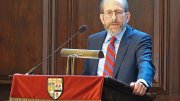Harvard College received 34,285 applications for admission to the class of 2016, about 2 percent fewer than the 34,950 received last year. According to the College’s news release, William R. Fitzsimmons, dean of admissions and financial aid, attributed the decline, after a half-decade of steady increases, to a pair of factors:
The return of Early Action [with notice of decisions in December] here and at Princeton and the University of Virginia may have led more students to make their college choices earlier and not apply to as many colleges in Regular Action. And demographic downturns in the number of high-school seniors, particularly in the Northeast (which will continue over the next few years), may also have played a part. If so, we may experience a period of greater stability and less frenzy in college admissions, a welcome result for everyone.
Those early applicants on whom decisions were deferred and regular applicants will be notified of Harvard’s decision on March 29. In 2011, the College admitted 2,158 applicants to the class of 2015, an acceptance rate of 6.2 percent.
The news release also highlighted a change in applications from international students: a modest (5 percent) increase in the international pool, compared with a 20 percent increase last year (from 5,006 to 6,014). A possible explanation was offered by Marlyn McGrath, director of admissions:
Outreach to international students by American colleges and universities historically has usually produced large annual gains as relatively few international students had ever considered coming to the United States for college. Now an American college education is considered a normal option by more international students than in the past.
Among other schools reporting, Yale said it had received a record 28,870 applications this year, an increase of 5.8 percent. The Columbia Spectator reported that Columbia received 8.9 percent fewer applications (a total of 31,818); MIT’s pool increased 1 percent, and Penn’s declined 1.7 percent, according to Bloomberg. In some cases, institutions cited the effect on their applicant cohort this year of the return of early-action options at Harvard, Princeton, and Virginia; in others, results this year reflect a more stable level of applications following surges in prior years when an institution adopted the common application.








